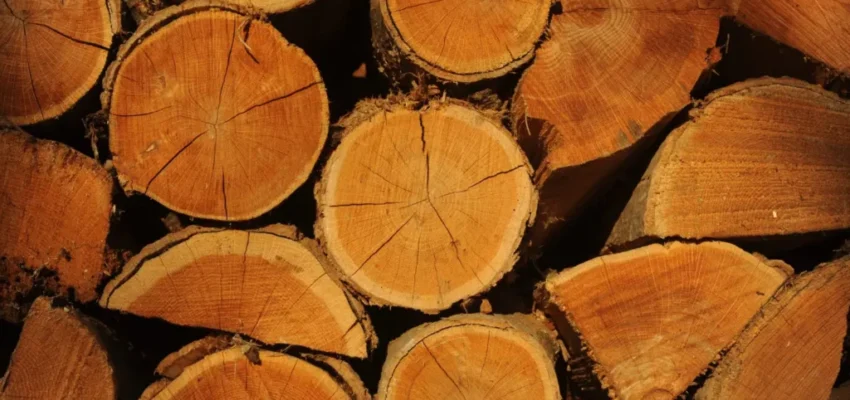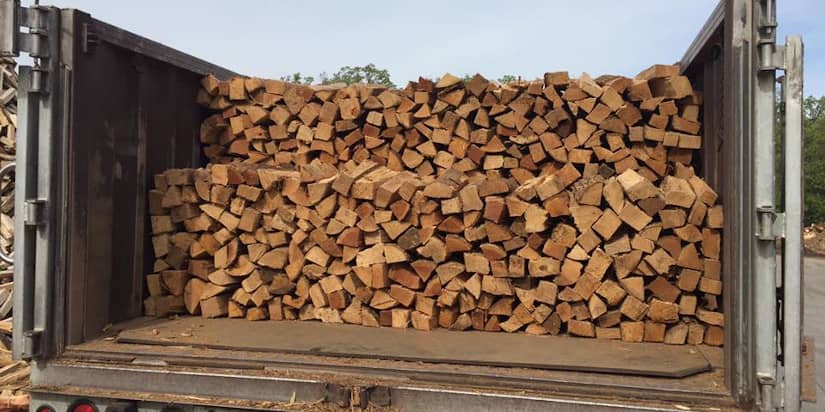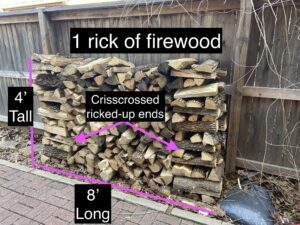A rick of firewood is a neatly stacked pile of firewood that measures 4 feet high, 8 feet long, and 16 inches wide. It is used as a standard measurement for selling and storing firewood.
Firewood is a crucial resource for those who depend on it to keep warm during winter or enjoy cozy bonfires. To ensure an adequate supply, it’s essential to understand the measurement unit commonly used in the firewood industry: the rick of firewood.
This compact pile, also known as a face cord, is carefully stacked and contains a specific amount of wood. Typically measuring 4 feet high, 8 feet long, and 16 inches wide, a rick of firewood serves as a standard measurement for consumers to purchase and store wood. Whether you’re a seasoned firewood enthusiast or a first-time buyer, it’s crucial to comprehend this unit of measurement to make informed decisions about your firewood needs. We will delve deeper into what constitutes a rick of firewood, its benefits, and how it can assist in ensuring an efficient supply of fuel for your fire-related activities.

Credit: usvintagewood.com
The Basics Of A Rick Of Firewood
In this blog post, we will be exploring the concept of a rick of firewood. Firewood is a popular choice for heating and cooking in many households, and understanding the basics of a rick of firewood can help you make an informed decision when purchasing or storing your firewood.
Definition Of A Rick Of Firewood
A rick of firewood is a standard unit of measurement used to quantify the amount of firewood in a stacked pile. It is typically a rectangular or square-shaped structure composed of evenly cut and stacked logs. The term “rick” can vary in different regions and can be referred to as a “cord,” “face cord,” or “rick cord.”
Standard Dimensions
The dimensions of a rick of firewood can also vary depending on the region, but there are general guidelines to follow. A standard rick of firewood measures approximately 4 feet high, 8 feet long, and 4 feet wide. The logs within the rick are usually cut to a consistent length that ranges from 12 to 18 inches.
Here’s a breakdown of the standard dimensions of a rick of firewood:
| Dimension | Measurement |
|---|---|
| Height | 4 feet |
| Length | 8 feet |
| Width | 4 feet |
It’s worth noting that while these dimensions are considered standard, variations may occur based on supplier preferences or specific regional requirements.
Knowing the standard dimensions of a rick of firewood can be valuable when you need to estimate the amount of firewood you will need for a specific period. Additionally, understanding these dimensions can assist you in determining how much space is required for storage purposes.
Now that you are familiar with the definition and standard dimensions of a rick of firewood, you can confidently navigate the world of firewood with a better understanding of how much wood to expect when purchasing or storing firewood.

Credit: lumberjax.com
Benefits Of Using A Rick Of Firewood
A Rick of Firewood is a stack measure equivalent to about 1/3 cord. This convenient quantity provides an accessible amount of firewood for home use, offering easy storage and manageable handling. Using a Rick of Firewood ensures a steady supply for heating and cooking, making it a practical choice for households.
Burning firewood is not only a traditional way of heating but also comes with several benefits that make it an attractive option for many homeowners. Using a rick of firewood provides a cost-effective, convenient, and accessible solution to keep your home warm during the colder months. Let’s explore these benefits in detail:
Cost-effective Heating Option
Wood is known to be a relatively affordable and cost-effective heating option compared to other fuel sources. By using a rick of firewood, you can save on your utility bills, especially if you have access to a reliable and sustainable source of firewood. With rising energy costs, using firewood can bring significant savings to your household budget, enabling you to allocate those funds to other essential expenses.
Moreover, purchasing firewood in bulk, such as a rick or a large stack, often comes at a lower price per unit compared to smaller quantities. This further enhances the cost-effectiveness of using firewood for heating your home.
Convenience And Accessibility
Another advantage of using a rick of firewood is the convenience it offers. Once you have a sufficient supply of firewood stacked in your yard, you will have ready access to fuel for your fireplace or wood-burning stove throughout the winter season. This eliminates the need to rely solely on central heating systems or gas and electricity providers, giving you greater control over your heating requirements.
The accessibility of firewood is another benefit worth highlighting. Many regions have ample access to firewood, making it readily available for purchase or even for free if you have the means to collect and process it yourself. This accessibility ensures that firewood remains a viable and practical option for heating, regardless of your location.
Additionally, firewood can often be sourced locally, reducing transportation costs and the associated carbon footprint. This enhances the environmental sustainability of using firewood as a heating option, making it an appealing choice for those who prioritize eco-friendliness.
| Benefits of Using a Rick of Firewood: | |
|---|---|
| Cost-Effective Heating Option |
|
| Convenience and Accessibility |
|
Types Of Firewood Ideal For Ricks
Hardwood Varieties
Ricks of firewood are a convenient way to store and transport wood for burning in fireplaces, stoves, or outdoor fire pits. When it comes to selecting the ideal firewood for ricks, hardwood varieties are a popular choice due to their density, slow-burning properties, and high heat output. Here are some of the hardwood species that are considered ideal for ricks:
- Oak: Known for its slow and steady burn, oak firewood produces a long-lasting and consistent heat ideal for prolonged fires.
- Maple: Maple firewood offers a clean and consistent burn with a pleasant aroma, making it a favorite for indoor heating.
- Hickory: With a high heat output and a distinctive smoky flavor, hickory firewood is favored for smoking meats and adding flavor to outdoor cooking.
Softwood Varieties
Softwood varieties are also suitable for ricks, especially for kindling and quick-starting fires. They are known for igniting easily and producing a lively flame. Despite burning faster than hardwoods, softwoods have their own advantages. Here are some softwood varieties ideal for ricks:
- Pine: Pine firewood ignites easily and releases a pleasant aroma, making it great for kindling and adding fragrance to a fire.
- Cedar: Often used for outdoor fires, cedar firewood burns quickly with crackling sounds, adding an atmospheric touch to the outdoor experience.
- Spruce: This softwood variety is valued for its quick-burning and aromatic qualities, making it an excellent choice for starting fires and adding a pleasant scent to an indoor fire.
Proper Storage And Maintenance
A rick of firewood is a standard measurement for storing and maintaining firewood. It refers to a stack of wood that is approximately 4×8 feet in size and is commonly used for heating purposes. Proper storage and maintenance of firewood ensure its quality and efficiency when used for heating.
Proper Storage and Maintenance
When it comes to keeping your firewood in optimal condition, proper storage and maintenance are crucial. In this section, we will discuss the essential steps you need to take to ensure your firewood stays dry and ready for use. From choosing the right location to ensuring proper air circulation, these guidelines will help you make the most out of your rick of firewood.
Choosing The Right Location
To start, selecting the right location for storing your firewood is key. Look for a spot that is well-ventilated and protected from the elements, such as a covered porch or a shed. This will shield the firewood from excessive moisture and prevent it from getting drenched during rain or snowfall.
Additionally, it is essential to keep the firewood off the ground to avoid any potential moisture absorption. Use a rack or pallet to elevate the firewood, maintaining a gap between the ground and the logs.
Ensuring Proper Air Circulation
Proper air circulation is vital in preventing the growth of mold and mildew on your firewood. When stacking the logs, be sure to leave enough space between each piece to allow for adequate airflow. This will help the wood dry out and reduce the chances of decay.
Moreover, consider stacking the logs in a way that allows air to circulate through the stack itself. This can be achieved by creating vertical columns or using a crisscross pattern. Remember to avoid tightly packed stacks that restrict airflow, leading to damp and ineffective firewood.
Maintaining The Firewood Stack
To maintain your firewood stack, keep an eye out for any signs of insect infestation or decay. Regularly inspect the wood for bugs, such as termites or carpenter ants, and promptly take action if you detect their presence. Applying an appropriate insecticide can help protect the stacked firewood from these destructive pests.
Furthermore, it is important to rotate the firewood stack regularly. By moving the older wood to the front and placing newer logs at the rear, you ensure that the oldest logs are used first. This practice helps to avoid any potential waste from deterioration and guarantees that you are always using the driest logs.
In conclusion, proper storage and maintenance of your rick of firewood are of utmost importance to ensure it remains in excellent condition for use. Choosing the right location, ensuring proper air circulation, and maintaining the stack will result in dry and long-lasting firewood that provides the warmth and coziness you desire during those colder months.
Environmental Impact And Sustainability
When it comes to the environmental impact and sustainability of firewood, it is important to consider how it is sourced and used. Firewood is renowned for being a renewable resource that has minimal negative effects on the environment. From minimizing carbon footprint to promoting sustainability, firewood brings forth several benefits.
Renewable Resource
Firewood is a prime example of a renewable resource as it comes from renewable and sustainable sources. Unlike fossil fuels, which are finite and contribute to greenhouse gas emissions, firewood can be replenished through responsible forest management practices.
Minimizing Carbon Footprint
Using firewood as a fuel source can significantly minimize carbon footprint. When properly harvested and burned, firewood emits lower levels of carbon dioxide compared to other fossil fuels. This is because the carbon released during burning is part of a natural carbon cycle, where trees absorb carbon dioxide from the atmosphere as they grow.
In addition, firewood production and transportation generally produce fewer carbon emissions compared to the extraction and transportation of fossil fuels. Therefore, choosing firewood as an alternative fuel source can contribute to reducing carbon emissions and combat climate change.
By using firewood efficiently and responsibly, individuals can further reduce their carbon footprint. Properly seasoned and dried firewood burns more efficiently, releasing fewer emissions. It is important to avoid burning wet or green wood, as this produces more smoke and harmful pollutants.
Moreover, firewood can be sourced locally, reducing the need for long-distance transportation and minimizing the associated carbon emissions. Buying firewood from local suppliers not only supports the local economy but also reduces the environmental impact of transportation.

Credit: firewoodtulsa.com
Frequently Asked Questions Of What Is A Rick Of Firewood
How Much Firewood Is In A Rick?
A rick of firewood typically contains about 1. 5 cords, which is equivalent to 128 cubic feet or about 3. 6 cubic meters of wood.
Why Do They Call It A Rick Of Firewood?
A rick of firewood is a specific measurement used for stacking firewood. It typically consists of a pile of wood that is 4 feet high, 8 feet long, and one log deep. The term “rick” comes from an old Norse word meaning “heap” or “stack.
How Many Bundles Are In A Rick Of Firewood?
A rick of firewood typically contains 3 to 4 bundles.
Will A Rick Of Wood Fit In A Pickup?
Yes, a pickup can typically accommodate a rick of wood due to its open bed design and adjustable features.
Conclusion
Understanding what a rick of firewood is can help you make informed decisions when purchasing firewood. By knowing the dimensions and quantity of a rick, you can estimate how much firewood you need and ensure you have enough to keep warm during the winter months.
Plus, a rick can also help you determine the cost-effectiveness of your firewood purchase.


